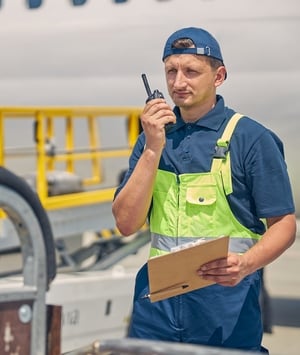Recognizing Good Aviation Risk Management Training Is Crucial

Having good aviation risk management training is perhaps one of the most important ways to improve safety in your organization.
Good training is not inexpensive, as it takes you and/or your employees away from regular duties. In other words, management doesn't want to waste time and money on items that have no direct and immediate relation to the bottom line. They expect to see results from their investment.
Simply put, bad training is a risk that needs to be accounted for.
Related Aviation SMS Training Articles
- Training Management in Aviation SMS
- 6 Tips to Improve Aviation SMS Training Courses
- 3 Biggest Aviation Risk Management Training Mistakes
Bad aviation safety training is completely useless. If anything, bad training has a negative impact on your aviation safety program:
- It cultivates apathy about safety issues;
- It embitters employees that they have to waste their time;
- It weakens trust in the aviation SMS; and
- It gives the illusion of safety security on paper without any actual increase in safety ability.
Good risk management training has the exact opposite effects:
- It cultivates knowledge about safety events;
- It empowers employees about operating safety in the SMS program;
- It improves hazard reporting cultures;
- It creates "safety champions" to promote the SMS; and
- Safety managers can actively depend on the results of good safety training.
To avoid the bad and capitalize on the benefits, safety managers should be able to distinguish good aviation safety training from bad safety training. This starts by looking at the syllabus and paying careful attention to three things:
- What are the learning outcomes/goals;
- The methodology; and
- Structure of the course
While considering these three things, here are 5 signs of good risk management training courses in the aviation industry.
1 – Pre and End of Training Assessments

If you really want to know how effective an aviation risk management training course is, you need to look no further than a pre-course assessment and end-of-course assessment. Without both assessments, you will have very little idea about how effective the training was in improving your abilities/knowledge.
Having end-of-course training is useful, but not good enough. With just end-of-course assessments, you have no reference point. For example:
- Let’s say you receive a 90% score on a final assessment
- That sounds like the training course did a great job; but
- If you had also taken a pre-assessment and received 85%, then the training actually only marginally improved your abilities.
Pre and end-of-course assessments also provide other quantifiable long-term benefits for your company that are useful for safety performance monitoring;
- Track average training assessment scores (for different training topics) for your organization over time;
- Track individual employees score over time; and
- Monitor average pre-to-end assessment improvements to assess whether current training is effective or not.
Assessments before and after training are both crucial for understanding the quality of an aviation risk management training course. If a training course does not include these elements, you may want to look elsewhere.
Related Safety Performance Monitoring Articles
- How to Conduct Safety Performance Monitoring and Measurement
- How to Monitor Aviation Safety Culture Performance
- My Safety Score - What's Yours? Safety Performance Monitoring for Aviation SMS
2 – Practical Application vs Definitions or Concepts
Without question, this is the most problematic aspect of most training courses. It’s as simple as this – learning outcomes are mostly:
- Being able to give definitions;
- Understanding safety concepts; and
- Understanding the meaning of ideas.
All three points are an important aspect of any training course, and they most definitely need to be integrated into the training curriculum. But they should NOT be the primary goals of any training. The primary goals of any training SHOULD be:
- Application of concepts;
- Practical use of ideas; and
- Ability to identify “definitions” in the operational environment.
All three above points will be immensely more useful in the actual work environment. Training that focuses on these points takes the training a whole step further than merely remaining on an “academic” (i.e., definitions, concepts, ideas) level. Academic training will be forgotten right away.
Good learning outcomes emphasize and demonstrate the application of SMS risk management concepts. Furthermore, students should be left with a concrete understanding of how to integrate these concepts into their daily job duties.
3 – Relevant to Your Aviation SMS Program
Material needs to be relevant to your operational environment. Period. If trainees don’t have a strong, relevant reference point for the training material, the important points will be missed.
This point is tied in with the previous point. It’s very difficult for “academic” oriented training courses to create relevancy for trainees. But for the training provider, such a curriculum requires significantly less work and involvement than practical application courses.
Courses that feature practical uses and applications stand a much better chance of being relevant for all trainees. This is because hands-on activities require that trainees bridge the gap between their work experience and the training material.
Related Aviation SMS Training Articles
- 3 Critical Topics for Aviation SMS Training to Focus On
- Best Ways to Automate Aviation Safety Training for Initial/Recurrent Requirements (Free Resources)
- Aviation SMS Training – Meet Your Objectives Easily – With Templates
4 – More Doing, Less Listening

For most people, lectures are dreadfully boring. “Lecturing” is a risk management training plague in the aviation industry. It makes safety training seem significantly longer and is enough to make anyone cringe at the thought of having to attend another dreadfully boring training.
As a former teacher, it’s a no-brainer that training needs to:
- Be hands-on;
- Involve lots of “doing,” such as completing problems, analyzing, etc.;
- Use scenarios; and
- Be interactive and collaborative.
Essentially, good training teaches by doing rather than talking. This methodology involves
- Less note-taking and more problem-solving;
- Less listening and more question-asking; and
- More application and less demonstration.
Granted, a demonstration is important. But working through problems and failing to arrive at the correct result is significantly more effective at teaching than simply having an instructor demonstrate the correct way to do something over and over.
Demonstration is a critical part of introducing new material. But actually working with the material is the primary way for learning it.
5 – Take Home Materials and Reference
A dead giveaway of quality training is that you finish the training with take-home materials that you worked on during the training. Several pages of notes do not count as take-home material.
What it comes down to is this:
- Materials you bring home to demonstrate what you actually did during training; and
- They will be much more helpful as reference material than a pile of notes.
Good take-home reference materials are:
- Diagrams and workflows;
- Walk-through pictures, bullet points, etc.;
- Problems you solve (with corrections)’; and
- Assessments with scores/corrections; and
- A list of helpful resources.
The other benefit of take-home materials is that you can recycle what you learned for the benefit of other employees in your organization.
Related Aviation SMS Training Articles
- 4 Pillars | 10 Things You Need to Know About Aviation Safety Training
- What Is Aviation Safety Training in Aviation SMS - Includes Videos to Use
- SMS Chart: Where to Focus Hazard Identification Training & Risk Mitigation
Final Thoughts on Risk Management Training
Nobody likes thinking about how they wasted a day sitting in a classroom. There must be value in the training, i.e., value to the:
- Employee;
- Organization; and
- Aviation industry.
Consider what value your training materials bring to the stakeholders. Risk management training does not excite everyone, especially those who would rather be flying. We hope you can find unique ways to make your training interesting and worthwhile for all stakeholders.
You may find this free Hazards and Risks Competency Assessment (with answers and explanations) useful as both an assessment and training tool:
Last updated in March 2025.








